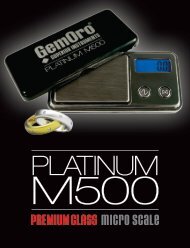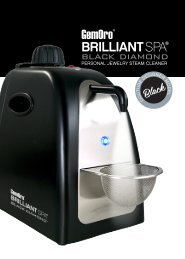OPERATING PROCEDURE & OWNERS MANUAL - Sykessler
OPERATING PROCEDURE & OWNERS MANUAL - Sykessler
OPERATING PROCEDURE & OWNERS MANUAL - Sykessler
Create successful ePaper yourself
Turn your PDF publications into a flip-book with our unique Google optimized e-Paper software.
a different location within the range of that karat.<br />
If it is platinum, the LED bar graph will go to PT<br />
or rest at the end of the spectrum often because<br />
of a rhodium plating commonly applied over the<br />
platinum.<br />
Due to the subtle differences in karat gold above<br />
18K, including the fact that the alloys used vary<br />
from silver to copper, nickel, zinc, palladium,<br />
rhodium, and aluminum, the testing results for<br />
this higher karat gold could be inconsistent. It is<br />
important to note that in the vast majority of the<br />
times, the AGT1 will test gold above 18K perfectly<br />
well and better than any other tester in its class.<br />
Also, since the vast majority of gold is 18K or lower,<br />
the occurrence of an inconsistent test for high karat<br />
gold above 18K will be very small.<br />
Maintenance:<br />
1. The AGT1 is a very sensitive instrument. You<br />
should always protect it when it is not in use.<br />
2. Always replace the protective cap on the pen<br />
probe when not in use to keep the probe tip from<br />
becoming damaged, dried out or contaminated.<br />
The cap should be pushed fully onto the pen such<br />
that it “clicks” into place. If the cap is not replaced<br />
for an extended period of time, a granular salting<br />
substance will appear corroding the probe tip and<br />
if this happens simply use a paper towel to remove<br />
this crust. If the probe is left uncapped for a long<br />
period of time the probe will likely need to be<br />
replaced.<br />
13 AuRACLE Gold Tester







